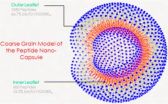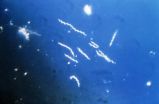(Press-News.org) The importance of fizz, more technically known as effervescence, in sparkling wines and champagnes is not to be underestimated — it contributes to the complete sensory experience of a glass, or flute, of fine bubbly. A scientist has now closely examined the factors that affect these bubbles, and he has come up with an estimate of just how many are in each glass. The report appears in ACS' The Journal of Physical Chemistry B.
Gérard Liger-Belair notes that effervescence plays an important role in the look, taste, aroma and mouth feel of champagne and other sparkling wines. Wine journalists and bloggers often cite 15 million as the average number of bubbles fizzing in a single glass of champagne, based on some simple mathematics. Sounds impressive, but Liger-Belair suspected that the formula leading to this estimate oversimplified the matter. It didn't take into account the fact that some of the dissolved carbon dioxide escapes from a glass without forming bubbles. Also, the size of the bubbles changes over time, and this could affect the final number. Liger-Belair wanted to set the record straight.
Taking into consideration temperature, bubble dynamics and the tilt of a flute, Liger-Belair came up with a new way to calculate the number of bubbles in a glass of champagne. And the result is far lower than what has been cited. "One million bubbles seems to be a reasonable approximation for the whole number of bubbles likely to form if you resist drinking champagne from your flute," he concludes. He also found that if you prefer more fizz in your bubbly, serve it warmer than you normally would and be sure to tilt the flute when pouring.
INFORMATION:
The authors acknowledge funding from the Europôl' Agro Institute and the Association Recherche Oenologie Champagne Université.
The American Chemical Society is a nonprofit organization chartered by the U.S. Congress. With more than 161,000 members, ACS is the world's largest scientific society and a global leader in providing access to chemistry-related research through its multiple databases, peer-reviewed journals and scientific conferences. Its main offices are in Washington, D.C., and Columbus, Ohio.
To automatically receive news releases from the American Chemical Society, contact newsroom@acs.org.
Follow us: Twitter Facebook
The science of champagne fizz: How many bubbles are in your bubbly?
2014-04-02
ELSE PRESS RELEASES FROM THIS DATE:
Albertans support perinatal mental health screening
2014-04-02
After struggling with anxiety and depression since her teens, Lana Berry hit bottom at age 26. Divorced, unemployed and back living with her parents, she found herself in a dark place—"as sick as I'd ever been."
Berry persevered, pouring her energy into getting better. She found work, met the love of her life, remarried and, six years after her low point, found out she was going to be a mom. Given her past, she was understandably anxious about what to expect.
"I did have worries, but I didn't have regular conversations with doctors about depression. They would only ...
Radiation able to be securely stored in nontoxic molecule, study finds
2014-04-02
MANHATTAN, Kan. — Researchers have discovered that microscopic "bubbles" developed at Kansas State University are safe and effective storage lockers for harmful isotopes that emit ionizing radiation for treating tumors.
The findings can benefit patient health and advance radiation therapy used to treat cancer and other diseases, said John M. Tomich, a professor of biochemistry and molecular biophysics who is affiliated with the university's Johnson Cancer Research Center.
Tomich conducted the study with Ekaterina Dadachova, a radiochemistry specialist at Albert Einstein ...
From Martian rocks, a planet's watery story emerges
2014-04-02
After 18 months on Mars, the rover Curiosity has taken more than 120,000 measurements of surface rocks and soil, painting a more detailed image of how much water was once on the Red Planet. An article in Chemical & Engineering News (C&EN) describes the technique scientists are using to analyze the rocks and what they've found.
Celia Arnaud, a senior editor at C&EN, notes that Curiosity has traveled nearly 4 miles since it landed in 2012 and is more than halfway to its destination, Mount Sharp. But in the meantime, its onboard equipment is collecting a treasure trove of ...
Noisy brain signals: How the schizophrenic brain misinterprets the world
2014-04-02
People with schizophrenia often misinterpret what they see and experience in the world. New research provides insight into the brain mechanisms that might be responsible for this misinterpretation. The study from the Montreal Neurological Institute and Hospital – The Neuro - at McGill University and McGill University Health Centre, reveals that certain errors in visual perception in people with schizophrenia are consistent with interference or 'noise' in a brain signal known as a corollary discharge. Corollary discharges are found throughout the animal kingdom, from bugs ...
Strain-specific Lyme disease immunity lasts for years, Penn research finds
2014-04-02
Lyme disease, if not treated promptly with antibiotics, can become a lingering problem for those infected. But a new study led by researchers from the University of Pennsylvania has some brighter news: Once infected with a particular strain of the disease-causing bacteria, humans appear to develop immunity against that strain that can last six to nine years.
The finding doesn't give people who have already had the disease license to wander outside DEET-less, however. At least 16 different strains of the Lyme disease bacterium have been shown to infect humans in the United ...
Criticism of violent video games has decreased as technology has improved, gamers age
2014-04-02
COLUMBIA, Mo. – Members of the media and others often have attributed violence in video games as a potential cause of social ills, such as increased levels of teen violence and school shootings. Now, a University of Missouri researcher has found that media acceptance of video game violence has increased as video game technology has improved over time. Greg Perreault, a doctoral student at the MU School of Journalism, examined the coverage of violent video games throughout the 1990s by GamePro Magazine, the most popular video game news magazine during that time period. Perreault ...
Food pantry clients struggle to afford diapers, detergent, other non-food items
2014-04-02
URBANA, Ill. - Many food-insecure families also struggle to afford basic non-food household goods, such as personal care, household, and baby-care products, according to a new University of Illinois study published in the Journal of Family and Economic Issues.
"These families often make trade-offs with other living expenses and employ coping strategies in an effort to secure such household items as toilet paper, toothpaste, soap, or disposable diapers. What's more, nearly three in four low-income families have cut back on food in the past year in order to afford these ...
Strain can alter materials' properties
2014-04-02
In the ongoing search for new materials for fuel cells, batteries, photovoltaics, separation membranes, and electronic devices, one newer approach involves applying and managing stresses within known materials to give them dramatically different properties.
This development has been very exciting, says MIT associate professor of nuclear science and engineering Bilge Yildiz, one of the pioneers of this approach: "Traditionally, we make materials by changing compositions and structures, but we are now recognizing that strain is an additional parameter that we can change, ...
Researchers identify how zinc regulates a key enzyme involved in cell death
2014-04-02
The molecular details of how zinc, an essential trace element of human metabolism, interacts with the enzyme caspase-3, which is central to apoptosis or cell death, have been elucidated in a new study led by researchers at Virginia Commonwealth University. The study is featured on the cover of the April issue of the journal Angewandte Chemie's International Edition.
Dysregulation of apoptosis is implicated in cancer and neurodegenerative disease such as Alzheimer's disease. Zinc is known to affect the process by inhibiting the activity of caspases, which are important ...
The Neanderthal in us
2014-04-02
This news release is available in German. Although Neanderthals are extinct, fragments of their genomes persist in modern humans. These shared regions are unevenly distributed across the genome and some regions are particularly enriched with Neanderthal variants. An international team of researchers led by Philipp Khaitovich of the Max Planck Institute for Evolutionary Anthropology in Leipzig, Germany, and the CAS-MPG Partner Institute for Computational Biology in Shanghai, China, show that DNA sequences shared between modern humans and Neanderthals are specifically ...



